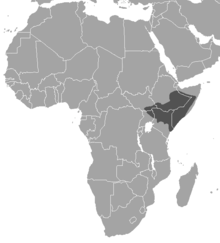Günther's dik-dik
| Günther's dik-dik | |
|---|---|

| |
| Günther's dik-dik at Samburu National Reserve, Kenya | |
| Scientific classification | |
| Domain: | Eukaryota |
| Kingdom: | Animalia |
| Phylum: | Chordata |
| Class: | Mammalia |
| Order: | Artiodactyla |
| Family: | Bovidae |
| Subfamily: | Antilopinae |
| Genus: | Madoqua |
| Species: | M. guentheri
|
| Binomial name | |
| Madoqua guentheri | |

| |
| The range of Günther's dik-dik | |
Günther's dik-dik (Madoqua guentheri) is a small antelope found in arid zones of East Africa.
Description
Günther's dik-dik is one of the smallest
Four subspecies have been proposed based on size and pelage features, but have not yet been analyzed genetically.[1]
Distribution and habitat
The species is found in the lowlands of Ethiopia, most of the northern and eastern regions of Kenya, Somalia excluding specific regions of the coast, limited regions of southeastern Sudan, and northeastern Uganda.[1][3] They avoid coastal regions. Typical habitat includes low thicket-type vegetation in thornbush, savanna grassland and riverine woodland biomes, and extends to disturbed and overgrazed areas. Habitat overlaps with other small antelope species such as Kirk's dik-dik.[3]
Ecology
Günther's dik-dik is a browser rather than a grazer, feeding mainly on the leaves, flowers, stems, fruits and seeds of non-grasses. The species feeds on plants close to the ground, due to its small stature. It is primarily diurnal, with activity peaks from dawn until mid-morning and mid-afternoon until after dark.[4] The species is monogamous; parents and calves do not form family groups for prolonged periods, and the calf is driven out at an early age to fend for itself.[3] Only a single calf is born at a time. The species does not breed seasonally and can have late gestation periods.[5]
While it has a limited vocal repertoire, the species has been shown to make use of the alarm calls of other species, for example responding with increased vigilance or flight behaviour to the alarm calls of the white-bellied go-away-bird.[6]
Conservation
The species is classified as
References
- ^ . Retrieved 19 November 2021.
- .
- ^ JSTOR 3504145. Archived from the original(PDF) on 2016-03-16. Retrieved 2016-11-18.
- .
- JSTOR 20095687.
- .
- PMID 18381260.

